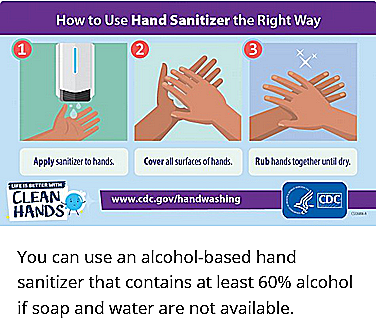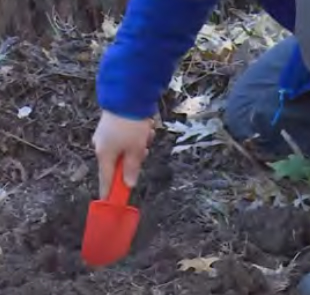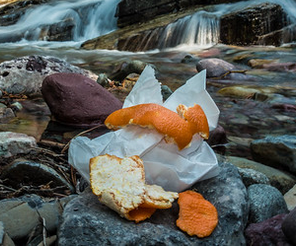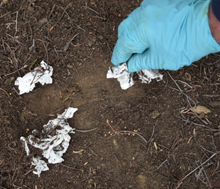There are no restrooms, privies or outhouses along most trails in the wilderness, or even close in to many developed areas in parks.
After we get to a trailhead (start of a hiking trail), and after we have packed up gear in our kayaks & canoes, we always plan to make one last stop at a restroom / outhouse, even if people are sure they don’t reeeealy need to, to prevent having to dig one more hole in the wilderness.
Away from toilet facilities, to deposit solid human waste, start by setting duff, pinecones, twigs aside carefully, then dig the hole. Mount Rainier says: “to promote decomposition, choose a site in organic soil rather than sandy mineral soil.”
Cover and disguise the cathole when finished by replacing duff, pinecones, etc.
(Yosemite) Deposit solid human waste in catholes (personal latrine) dug six inches deep at least 100 feet from water, camp, and trails.
(Grand Teton) “Urinate at least 200 feet away from any water source in rocky areas that will not be damaged by animals digging for salts and minerals found in urine. Bury feces 6-8 inches deep in soil and at least 200 feet from lakes, streams and wetlands.”
(Grand Canyon, 2021) “Where toilets are not available you must carry out your used toilet paper (a plastic ziplock bag works well) and bury feces in a small hole about 6 in / 15 cm deep. Be sure you are at least 200 ft / 60 m from trails, campsites, and water sources. Along the Colorado River, urinate directly into the wet sand at the river’s edge.”
(Everywhere) “Pack out used toilet paper, tampons, sanitary napkins and diapers in sealed plastic bags. Do not bury or burn them or dump anything in the backcountry outhouses. If you are in snow and can’t dig a hole into soil you are expected to pack out your waste as well.”
To truly be able to leave no trace and follow backcountry rules about camping the proper distance from a lake or digging your personal latrine hole the proper distance from water, etc.,
you will need to know how far 100 or 200 feet is.
Lay out a tape measure at home for 100 feet and walk it and count your paces.
When we did this before a student outing, the 100 feet came out to 40, 40, 42, 48, 48, 48 or 52 1/2 steps.
It isn’t possible to dig your cathole deep enough by scraping most soil with your boot heel/rock/stick, so carry a small lightweight garden trowel (lower cost than some for sale at recreation supply stores). The garden trowel might have a blade that is 6 inches long, you can use it to measure the hole depth. The trowel should only be used to dig the hole and should not get fecal matter on it. If your aim when you squat does not work to get the solid waste directly into the hole you dug, use a stick to push it in, not the trowel.
You can pack your trowel in a small bag with the closeable bag for the used toilet paper and some hand sanitizer or wipes (that need to also go into the trash bag after use).

Digging one big latrine for multiple people to use is not recommended, as “the digging and use of temporary latrines by backcountry visitors is almost always an inappropriate method for disposal. The larger the concentration of feces, the more time needed for decomposition, which increases both the likelihood that feces will be discovered by other visitors and that pathogens will come into contact with ground water.”
When you urinate on durable surfaces (rocks, gravel) that will not be damaged by animals digging for salts and minerals found in urine, (and not on plants that animals could try to chew on to get the salt) you could dilute the urine with a sprinkling of water.
Yosemite video on How to Poop in the Woods, which you will find links to at many National Park webpages:
https://www.nps.gov/media/video/view.htm?id=AEC52765-A123-6C46-F9251B8977933EDE
![]()
At many parks, in alpine zones, lakeside campsites and/or for all climbers, you must pack out all your own waste. “There is no good place to dig a cat-hole on alpine climbing routes and solid human waste left under rocks can last a long time in that environment.”
In Yosemite, the climbing regulations page
https://www.nps.gov/yose/planyourvisit/climbing_regulations.htm
has said:
“Tips for vertical relief
The Basics
Go to the bathroom in a paper bag or wag bag, and then put that bag in some sort of container to carry off the cliff (a difficult process at hanging belays, but one that can be mastered with practice, determination, and flexibility).
What to use?
Bottom line: use something, anything. Everyone has their own technique, but here are a few ideas to get you started:
For the classic “tube,” attach screw caps to each end of a large PVC pipe. Glue one end shut, and tape on some webbing for easy hauling. Durable and reusable, but it takes time and a hardware store.
If you’re short on time but not funds, commercial versions are available (check the Mountain Shop at Curry Village). Dry bags work as well, and there are even a handful of commercial kits available to replace paper bags.
If you’re short on time and funds, anything from a five-gallon bucket to reusable plastic containers can work in a pinch. These are durable, possibly reusable, and cheap.
Abandon the “tube” altogether in favor of a single use solution: water bottles. Once you’ve emptied a water bottle, make a vertical slit down the side, toss in your bag of business, and cover the slit with duct tape. Cheap and one less thing to carry.
Where do I empty it?
However you haul it, getting it to the summit is only the first part; it has to come down as well. The summits of popular big walls in Yosemite are often littered with stinking tubes. Carry your tube down and empty it into a pit toilet like those at the base of the East Ledges descent from El Capitan. Paper bags are fine to go down the drain but plastic bags are not (they clog the pumps used to empty the toilets). Plastic bags must be disposed of in a bearproof trash can or dumpster.”
Grand Teton National park has said:
“Toilet Bags Required for some Trips
The use of a landfill-safe commercial toilet bag system (such as Wag Bag, Restop, etc.) is required for some overnight backcountry trips including high alpine climbing areas and lake sites. Affected permit holders will be required to carry a minimum of one bag per person per night for the duration of their trip and present proof that they have the required number of bags before their permit will be issued. Bags may be available at permits desk but not guaranteed.”
![]()
Ranger and Exum camp on the Lower Saddle in Grand Teton National park:
Special regulations and camping limits apply in Garnet Canyon due to its unique character and the specialized use it receives.
See: https://tetonclimbinggarnet.blogspot.com/
where it said, in 2025: “Human Waste Disposal
All overnight campers at the Lower Saddle & Caves Camping Zones are required to take “Rest Stop” bags to pack out their human waste. Campers are also encouraged to use “Rest Stop” bags when staying elsewhere in Garnet Canyon. Bags are available for issue with a camping permit at the Jenny Lake Ranger Station. Semi-permanent plywood structures on the west side of the Lower Saddle help to facilitate use of the bags. Chemical polymers breaking down the solid waste allow for the bags to be deposited in any garbage can back on the valley floor. Additional information on proper use can be obtained at the Jenny Lake Ranger Station. We also request that people urinate on the west side of the Lower Saddle to help maintain a clean and pristine camping area and to prevent contamination of the water source on the east side.”
Amistad National Recreation Area has said: “Park visitors are required to carry out all solid human waste and toilet paper from backcountry areas of the park with a commercially-produced, spill-proof, and trash-container-safe waste bag system or with a dump-station-compatible waste system.”
Guadalupe Mountains Wilderness has said: “Day hikers and all permitted overnight backpackers are required to pack out human waste using a landfill-safe commercial toilet bag system. In areas more than a quarter of a mile from restroom facilities, and all areas inside the Wilderness boundary, all solid human waste, feminine hygiene products, and toilet paper must be carried out in a landfill-safe commercial toilet bag.”
Due to the rocky nature of the soils and dry environment in the park, the digging and use of “catholes” for human waste is prohibited. Depositing human waste and toilet paper in or on the landscape is prohibited.”
Proper waste disposal not only keeps the backcountry looking pristine, it is extremely important for health and safety of campers and wildlife.
Over 100 bacteria, protozoans, and viruses are potentially present in human feces and capable of causing illness.
Your toilet paper trash bag should be a separate one from the bag you carry for food trash.
Have a small trash bag handy on the trail, big enough for more than your own trash.
We have had competitions to see who could find and clean up the most (or weirdest) litter.
Get the trash into the bag as you create it, micro-trash often falls out of pockets and litters trails.
When you are about to leave, check your campsite and lunch stop for microtrash —look for bandages, twist ties, fruit peels, bits of wrappers, stray potato chips, torn corners of candy bar wrappers and power bars, plastic bottle caps, bits of G.O.R.P. etc.
Don’t burn or bury any trash, or dump anything in composting backcountry outhouses, even orange peels you think will biodegrade.
Please pick up after less thoughtful people who have gone before you.
If you decide to improve your karma, and the beauty of an off-trail spot, by cleaning up used toilet paper others left, remember that it has germs and carefully use a couple of twigs to get it into your trash bag without touching it, or even better, bring some extra non-latex first aid gloves to use:
There is more at Leave No Trace.
“Cigarette waste is the most commonly littered item in the US,
with 1.69 billion pounds polluting the environment every year.”
“While many people believe that cigarettes are biodegradable, the filters in almost all cigarettes are actually made of cellulose acetate, a type of plastic. When disposed of improperly, they release a long list of harmful chemicals into the environment (cadmium, lead, formaldehyde, arsenic, etc.). In addition to these challenges, carelessly tossed cigarette butts can also start forest fires, potentially damaging hundreds or thousands of acres, or make their way into the nests of birds and other animals along with other micro-trash items .”




